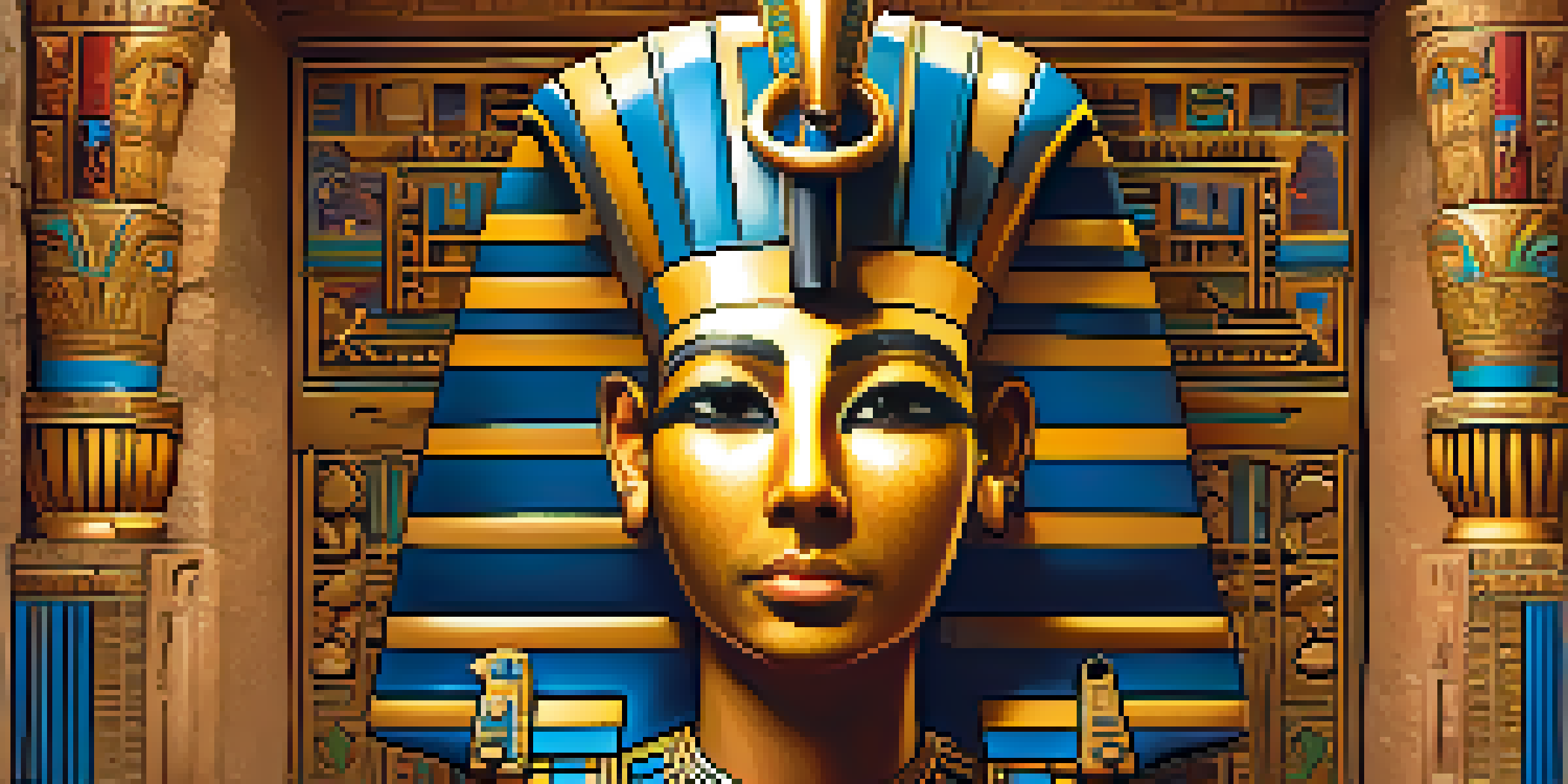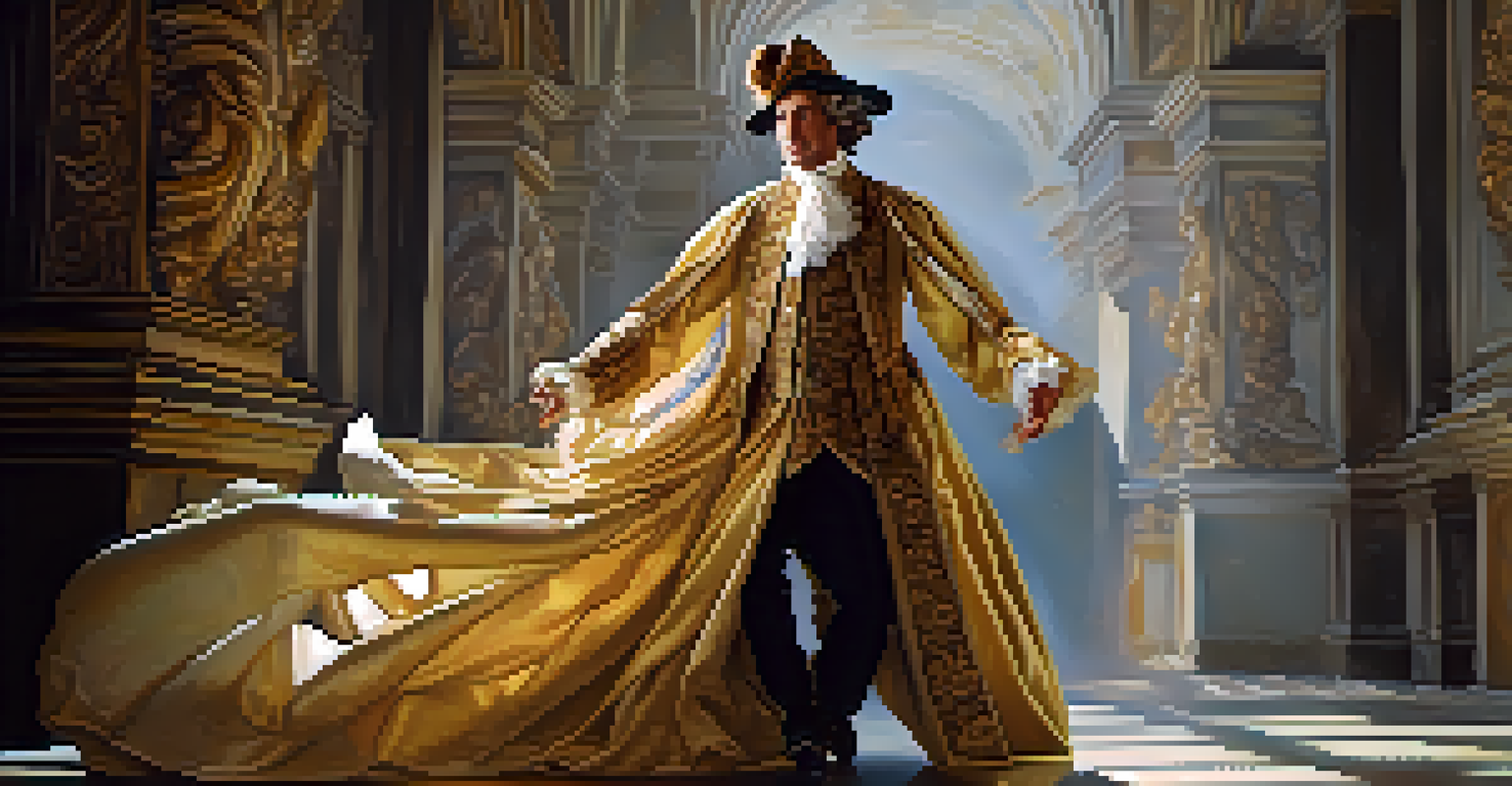The Origins of Portrait Painting: From Ancient to Modern Times

The Birth of Portrait Painting in Ancient Civilizations
Portrait painting has roots that stretch back to ancient civilizations, where representation of individuals served both practical and spiritual purposes. In Ancient Egypt, for instance, tomb paintings depicted the deceased, aiming to ensure their presence in the afterlife. Similarly, the Greeks and Romans created busts and frescoes that celebrated notable figures, intertwining art with status and legacy.
Art is the most beautiful of all lies.
These early portraits were less about capturing likeness and more focused on conveying ideals, such as power, divinity, and social standing. For the Egyptians, the depiction of pharaohs emphasized their god-like nature, while Greek portraits aimed for an idealized beauty. This use of art to convey deeper meanings laid the groundwork for future generations of portrait artists.
As we move forward through history, these early influences would evolve, shaping how artists approached the subject of the human face and form. The transition from symbolic representation to more realistic portrayals marks a significant turning point in the art world, setting the stage for the developments that would follow.
The Role of the Middle Ages in Shaping Portraiture
During the Middle Ages, portrait painting took on a more religious tone, with many works focusing on saints and biblical figures rather than individual likenesses. This period saw limited opportunities for personal portraiture, as art was primarily commissioned by the Church, emphasizing spiritual over secular concerns. Artists often used stylized forms and symbols to convey messages rather than striving for realism.

However, as the Renaissance approached, societal shifts began to change the landscape of art. The rediscovery of classical philosophy and humanism encouraged a renewed interest in the individual, leading to a gradual shift in portrait painting. Artists like Jan van Eyck began experimenting with oil paints, allowing for more detailed and lifelike representations.
Evolution of Portraiture Over Time
Portrait painting has transformed from ancient symbolic representations to modern explorations of identity and emotion.
This blend of religious themes with an emerging focus on individuality marked the beginning of a new era. The stage was set for artists to explore the complexities of human emotion and identity, paving the way for the masterpieces that would define the coming centuries.
The Renaissance: A Flourishing of Individuality in Portraits
The Renaissance period heralded a remarkable transformation in portrait painting, characterized by a newfound appreciation for realism and human emotion. Artists like Leonardo da Vinci and Raphael pushed the boundaries of their craft, capturing not just the physical attributes of their subjects but also their character and psychology. This era emphasized the importance of the individual, a stark contrast to the earlier, more symbolic representations.
The painter tries to master his art in order to express himself, not in order to please the world.
Portraits became a means of self-expression and status, with wealthy patrons commissioning works that celebrated their identity and achievements. The introduction of techniques such as chiaroscuro—using light and shadow to create depth—enhanced the lifelike quality of portraits. This era also saw the emergence of the three-quarter pose, allowing for a more dynamic representation of the human figure.
As portrait painting flourished, it began to reflect the complexities of human experience. The careful attention to detail and the exploration of personality made Renaissance portraits timeless, influencing countless artists in the centuries to come.
The Baroque Era: Drama and Emotion in Portraiture
The Baroque era brought a dramatic flair to portrait painting, emphasizing movement, emotion, and grandeur. Artists like Rembrandt and Velázquez transformed the genre by incorporating rich colors and dynamic compositions, allowing viewers to connect more deeply with the subjects. The portrayal of subjects in action or with expressive facial features injected a sense of realism and vitality into their work.
Portraits became more than static images; they were narratives that conveyed the stories of the subjects' lives. The use of elaborate costumes and intricate backgrounds further enhanced the viewer's experience, creating a sense of opulence. This period also saw the rise of group portraits, capturing the essence of social gatherings and the relationships between individuals.
Impact of the Renaissance
The Renaissance marked a pivotal shift towards realism, emphasizing individuality and the psychological depth of subjects.
The Baroque style's emphasis on emotion and drama left a lasting impression on portrait painting. It encouraged artists to explore the deeper aspects of human nature, which would resonate throughout art history and inspire future movements.
The 18th Century: Portraits and the Age of Enlightenment
The 18th century marked a pivotal moment in portrait painting, coinciding with the Age of Enlightenment, where reason and individualism took center stage. Artists like Thomas Gainsborough and Joshua Reynolds began to explore the interplay of light and color while focusing on the character of their subjects. This era saw an increased interest in portraying the nobility and the emerging bourgeoisie, emphasizing their social roles and accomplishments.
Portraits became a vehicle for expressing identity and personal narrative, often reflecting the aspirations of the subject. The rise of the middle class led to a greater demand for portraits, making art more accessible. This shift encouraged artists to experiment with styles and techniques, moving towards a more relaxed and informal representation of their subjects.
As portrait painting evolved during this time, it began to reflect broader societal changes. The emphasis on individuality and self-representation laid the groundwork for modern approaches to portraiture, making it a significant transition in the art world.
The 19th Century: A Shift Towards Realism and Impressionism
The 19th century saw a significant shift in portrait painting, as movements like Realism and Impressionism emerged, challenging traditional techniques and subjects. Artists like Gustave Courbet focused on depicting everyday life, steering away from idealized portrayals. This new approach aimed to capture the essence of the moment and the authenticity of the subject, making portraits more relatable to the average viewer.
Impressionists, such as Édouard Manet and Pierre-Auguste Renoir, broke away from conventional methods by emphasizing light and color over detail. Their work introduced a sense of spontaneity, with brushstrokes that conveyed movement and emotion. This fresh perspective encouraged artists to explore their subjects in new and innovative ways, setting the stage for modern portraiture.
20th Century's Diverse Innovations
The 20th century introduced various movements and the influence of photography, reshaping the approach to portrait painting.
As the century progressed, portrait painting became a reflection of society's evolving values. The move towards realism and impressionism highlighted the importance of personal experience and emotional connection, paving the way for the diverse styles that would emerge in the 20th century.
The 20th Century and Beyond: Diverse Styles and New Perspectives
The 20th century marked a turning point in portrait painting, with artists exploring a multitude of styles and techniques that challenged traditional notions of representation. Movements such as Cubism and Surrealism introduced new ways of seeing the human form, allowing artists like Pablo Picasso and Salvador Dalí to experiment with abstraction and symbolism. This expansion of artistic boundaries invited viewers to engage with portraits on a deeper, more conceptual level.
The rise of photography also changed the landscape of portraiture, as it became a popular medium for capturing likenesses. Artists began to question the need for realism in painting, leading to a focus on expression, identity, and the subconscious. The boundaries between fine art and popular culture blurred, as portraiture evolved to reflect contemporary issues and personal narratives.

Today, portrait painting continues to thrive, with artists drawing inspiration from diverse backgrounds and experiences. The genre remains a powerful tool for self-expression, allowing for the exploration of identity in a rapidly changing world. As we look ahead, the legacy of portrait painting will undoubtedly continue to evolve, reflecting the complexities of the human experience.